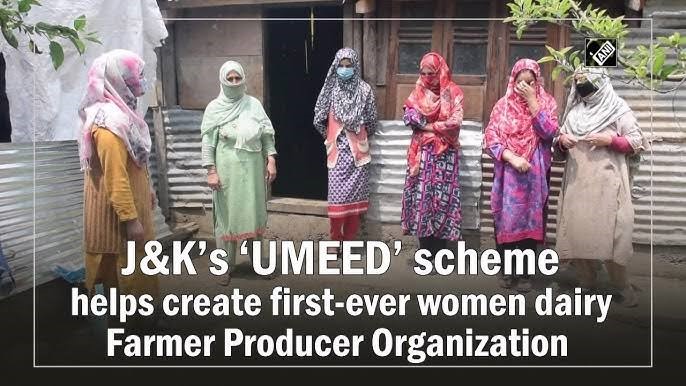
UMEED scheme

26.10.2023
UMEED scheme , Daily Current Affairs , RACE IAS : Best IAS Coaching in Kanpur
|
For Prelims: UMEED scheme,Jammu and Kashmir Rural Livelihoods Mission For mains GS paper 2: NRLM(Aim),About SHGs(Origin of SHGs and objective) Jammu & Kashmir(Geography,Economy) |
Why in the news?
A self-help group (SHG) recently launched a flower nursery as part of the UMEED scheme in Budgam.
About the UMEED scheme
- The UMEED scheme under the Jammu and Kashmir Rural Livelihoods Mission (JKRLM) is a centrally sponsored scheme to encourage women to be self-dependent and self-sufficient.
- The main objective of the scheme is to help the rural poor across Jammu and Kashmir.
- It also encourages women to make small savings so that their Self-Help Groups (SHGs) eventually become bankable at a reduced rate of interest.
- It helps women entrepreneurs exhibit and market their products.
- It is implemented by the Jammu & Kashmir State Rural Livelihoods Society.
Jammu and Kashmir Rural Livelihoods Mission (JKRLM):
- It is a poverty alleviation program with a strong focus on women’s empowerment through self-managed and sustainable institutional platforms.
- It emphasizes financial inclusion and the development of sustainable livelihoods.
- The mission’s core goal is to reduce poverty by establishing robust grassroots institutions for marginalized communities in Jammu and Kashmir. This involves engaging them in viable livelihood initiatives to ensure long-term income improvements.
- It is an adaptation of the National Rural Livelihoods Mission (NRLM), which is a flagship program of the Government of India.
- The program provides rural women with various platforms at different levels, including self-help groups, Village Organizations, Cluster Level Federations, and Block Level Federations, all of which play a crucial role in the mission’s implementation.
NRLM
- National Rural Livelihood Mission is also known as Aajeevika.
- It was launched by the Ministry of Rural Development (MoRD), Government of India in June 2011.
- The Scheme is assisted by investment from the World Bank.
- It aims to increase household income through sustainable livelihood enhancements and improved access to financial services.
- It promotes financial literacy among the poor and provides catalytic capital to the SHGs.
- It provides Revolving Fund (RF) and Community Investment Fund (CIF) as resources to the institutions in order to strengthen their institutional and financial management capacity.
- It is a scheme that is centrally sponsored where the finances of the programme are split in the ratio of 75:25 between the Central and the State Government.
Aim
- To concentrate on targets, outcomes, and time-bound delivery.
- To switch from the current allocation-based strategy to a demand-driven strategy, enabling the states to create their own livelihood-based poverty reduction action plans.
- To engage in continuous capacity building, impart necessary skills, and establish connections with opportunities for the poor to earn a living, including those emerging in the organized sector.
- To monitor progress toward targets of poverty outcomes.
About SHGs:
Origin of SHGs:
- It originated in 1975 in Bangladesh by Mohammed Yunus of Chittagong University. It is a programme related to the eradication of poverty in general, rural development through women empowerment in particular.
- Its initiation-credit in India in 1986-87 goes to National Bank for Agriculture and Rural Development (NABARD). But the real effort was taken after 1991-92 from the linkages of SHGs with banks.
- The first organised initiative in this direction was taken in Gujarat in 1954 when the Textile Labour Association (TLA) of Ahmedabad formed its women’s wing to organise the women belonging to households of mill workers in order to train them in primary skills like sewing, knitting embroidery, typesetting and stenography etc.
- In 1972, it was given a more systematized structure when Self Employed Women’s Association (SEWA) was formed as a Trade Union under the leadership of Ela Bhatt.
Objectives of SHG
- to inculcate the habit of thrift savings, banking culture, that is, availing the loan and repaying the same over a given period of time and in the process, again economic prosperity through credit. SHGs are mostly informal groups whose members pool their savings and relent within the group on a rotational or need basis.
Jammu & Kashmir
Geography
- It is situated between 32°17' and 36°58' north latitude and 73°26' and 83°30' east longitude.
- It is located in the extreme north of the country. It is bounded on north by China, on east by Tibet, on south by Himachal Pradesh, Punjab and on west by Pakistan.
- Geographically It is divided into four zones - the mountainous and semi-mountainous plain known as Kandi belt, hills including Siwalik ranges, mountains of Kashmir valley and Pir Pangal range and Tibetan tract of Ladakh and Kargil.
- It has a number of lakes, rivers, rivulets and glacial regions. The important rivers of this state are Indus, Chenab and Sutlej (Jhelum).
- There are extreme variations in climate in the state, due to its location and topography.
- The temperature of this state varies spatially.
- Leh is coldest and Jammu is the hottest.
Economy
Agriculture
Industry
Agriculture
- It is the mainstay of more than 80 percent people in Jammu & Kashmir.
- Major food crops are wheat, paddy and maize. Barley, jowar and bajra are cultivated in some parts of the state.
- Agro-climatic condition of this state supports horticulture.
- About 5 lakh families are directly or indirectly related with horticulture activities.
Industry
- Handicrafts, the traditional industry, are receiving top priority in view of employment potential and demand for wood carving, paper-machine, carpets, shawls, embroidery etc Carpets earn a substantial foreign exchange.
Source:ANI news